引言
在日常的后端開發工作中,最常見的操作之一就是看日志排查問題,對于大項目一般使用類似ELK的技術棧統一搜集日志,小項目就直接把日志打印到日志文件。那不管對于大項目或者小項目,查看日志都需要通過某個關鍵字進行搜索,從而快速定位到異常日志的位置來進一步排查問題。
對于后端初學者來說,日志的關鍵字可能就是直接打印某個業務的說明加上業務標識,如果出現問題直接搜索對應的說明或者標識。例如下單場景,可能就直接打印:創建訂單,訂單編號:xxxx,當有問題的時候,則直接搜索訂單編號或者創建訂單。在這種方式下,經常會搜索出多條日志,增加問題的排查時長。
所以,今天我們就來說一說這個關鍵字的設計,這里我們使用RequestId進行精確定位問題日志的位置從而解決問題。
需求
目標: 幫助開發快速定位日志位置
思路:當前端進行一次請求的時候,在進行業務邏輯處理之前我們需要生成一個唯一的RequestId,在業務邏輯處理過程中涉及到日志打印我們都需要帶上這個RequestId,最后響應給前端的數據結構同樣需要帶上RequestId。 這樣,每次請求都會有一個RequestId,當某個接口異常則通過前端反饋的RequestId,后端即可快速定位異常的日志位置。
總結下我們的需求:
- 一次請求生成一次RequestId,并且RequestId唯一
- 一次請求響應給前端,都需要返回RequestId字段,接口正常、業務異常、系統異常,都需要返回該字段
- 一次請求在控制臺或者日志文件打印的日志,都需要顯示RequestId
- 一次請求的入參和出參都需要打印
- 對于異步操作,需要在異步線程的日志同樣顯示RequestId
實現
- 實現生成和存儲RequestId的工具類
public class RequestIdUtils {
private static final ThreadLocal<UUID> requestIdHolder = new ThreadLocal<>();
private RequestIdUtils() {
}
public static void generateRequestId() {
requestIdHolder.set(UUID.randomUUID());
}
public static void generateRequestId(UUID uuid) {
requestIdHolder.set(uuid);
}
public static UUID getRequestId() {
return (UUID)requestIdHolder.get();
}
public static void removeRequestId() {
requestIdHolder.remove();
}
}
因為我們一次請求會生成一次RequestId,并且RequestId唯一,所以這里我們使用使用UUID來生成RequestId,并且用ThreadLocal進行存儲。
- 實現一個AOP,攔截所有的Controller的方法,這里是主要的處理邏輯
@Aspect
@Order
@Slf4j
public class ApiMessageAdvisor {
@Around("execution(public * org.anyin.gitee.shiro.controller..*Controller.*(..))")
public Object invokeAPI(ProceedingJoinPoint pjp) {
String apiName = this.getApiName(pjp);
// 生成RequestId
String requestId = this.getRequestId();
// 配置日志文件打印 REQUEST_ID
MDC.put("REQUEST_ID", requestId);
Object returnValue = null;
try{
// 打印請求參數
this.printRequestParam(apiName, pjp);
returnValue = pjp.proceed();
// 處理RequestId
this.handleRequestId(returnValue);
}catch (BusinessException ex){
// 業務異常
returnValue = this.handleBusinessException(apiName, ex);
}catch (Throwable ex){
// 系統異常
returnValue = this.handleSystemException(apiName, ex);
}finally {
// 打印響應參數
this.printResponse(apiName, returnValue);
RequestIdUtils.removeRequestId();
MDC.clear();
}
return returnValue;
}
/**
* 處理系統異常
* @param apiName 接口名稱
* @param ex 系統異常
* @return 返回參數
*/
private Response handleSystemException(String apiName, Throwable ex){
log.error("@Meet unknown error when do " + apiName + ":" + ex.getMessage(), ex);
Response response = new Response(BusinessCodeEnum.UNKNOWN_ERROR.getCode(), BusinessCodeEnum.UNKNOWN_ERROR.getMsg());
response.setRequestId(RequestIdUtils.getRequestId().toString());
return response;
}
/**
* 處理業務異常
* @param apiName 接口名稱
* @param ex 業務異常
* @return 返回參數
*/
private Response handleBusinessException(String apiName, BusinessException ex){
log.error("@Meet error when do " + apiName + "[" + ex.getCode() + "]:" + ex.getMsg(), ex);
Response response = new Response(ex.getCode(), ex.getMsg());
response.setRequestId(RequestIdUtils.getRequestId().toString());
return response;
}
/**
* 填充RequestId
* @param returnValue 返回參數
*/
private void handleRequestId(Object returnValue){
if(returnValue instanceof Response){
Response response = (Response)returnValue;
response.setRequestId(RequestIdUtils.getRequestId().toString());
}
}
/**
* 打印響應參數信息
* @param apiName 接口名稱
* @param returnValue 返回值
*/
private void printResponse(String apiName, Object returnValue){
if (log.isInfoEnabled()) {
log.info("@@{} done, response: {}", apiName, JSONUtil.toJsonStr(returnValue));
}
}
/**
* 打印請求參數信息
* @param apiName 接口名稱
* @param pjp 切點
*/
private void printRequestParam(String apiName, ProceedingJoinPoint pjp){
Object[] args = pjp.getArgs();
if(log.isInfoEnabled() && args != null&& args.length > 0){
for(Object o : args) {
if(!(o instanceof HttpServletRequest) && !(o instanceof HttpServletResponse) && !(o instanceof CommonsMultipartFile)) {
log.info("@@{} started, request: {}", apiName, JSONUtil.toJsonStr(o));
}
}
}
}
/**
* 獲取RequestId
* 優先從header頭獲取,如果沒有則自己生成
* @return RequestId
*/
private String getRequestId(){
// 因為如果有網關,則一般會從網關傳遞過來,所以優先從header頭獲取
ServletRequestAttributes attributes = (ServletRequestAttributes) RequestContextHolder.getRequestAttributes();
if(attributes != null && StringUtils.hasText(attributes.getRequest().getHeader("x-request-id"))) {
HttpServletRequest request = attributes.getRequest();
String requestId = request.getHeader("x-request-id");
UUID uuid = UUID.fromString(requestId);
RequestIdUtils.generateRequestId(uuid);
return requestId;
}
UUID existUUID = RequestIdUtils.getRequestId();
if(existUUID != null){
return existUUID.toString();
}
RequestIdUtils.generateRequestId();
return RequestIdUtils.getRequestId().toString();
}
/**
* 獲取當前接口對應的類名和方法名
* @param pjp 切點
* @return apiName
*/
private String getApiName(ProceedingJoinPoint pjp){
String apiClassName = pjp.getTarget().getClass().getSimpleName();
String methodName = pjp.getSignature().getName();
return apiClassName.concat(":").concat(methodName);
}
}
簡單說明:
- 對于RequestId的獲取方法 getRequestId,我們優先從header頭獲取,有網關的場景下一般會從網關傳遞過來;其次判斷是否已經存在,如果存在則直接返回,這里是為了兼容有過濾器并且在過濾器生成了RequestId的場景;最后之前2中場景都未找到RequestId,則自己生成,并且返回
- MDC.put("REQUEST_ID", requestId) 在我們生成RequestId之后,需要設置到日志系統中,這樣子日志文件才能打印RequestId
- printRequestParam 和 printResponse 是打印請求參數和響應參數,如果是高并發或者參數很多的場景下,最好不要打印
- handleRequestId 、 handleBusinessException 、 handleSystemException 這三個方法分別是在接口正常、接口業務異常、接口系統異常的場景下設置RequestId
- 日志文件配置
<contextName>logback</contextName>
<springProperty scope="context" name="level" source="logging.level.root"/>
<springProperty scope="context" name="path" source="logging.file.path"/>
<Appender name="console" class="ch.qos.logback.core.ConsoleAppender">
<Target>System.out</Target>
<filter class="ch.qos.logback.classic.filter.ThresholdFilter" >
<level>DEBUG</level>
</filter>
<encoder>
<pattern>%d{yyyy-MM-dd HH:mm:ss.SSS} [%X{REQUEST_ID}] [%thread] [%-5level] [%logger{0}:%L] : %msg%n</pattern>
</encoder>
</appender>
<appender name="file" class="ch.qos.logback.core.rolling.RollingFileAppender">
<file>${path}</file>
<rollingPolicy class="ch.qos.logback.core.rolling.TimeBasedRollingPolicy">
<fileNamePattern>${path}.%d{yyyy-MM-dd}.zip</fileNamePattern>
</rollingPolicy>
<encoder>
<pattern>%d{yyyy-MM-dd HH:mm:ss.SSS} [%X{REQUEST_ID}] [%thread] [%-5level] [%logger{0}:%L] : %msg%n</pattern>
</encoder>
</appender>
<root level="${level}">
<appender-ref ref="console"/>
<appender-ref ref="file"/>
</root>
這里是一個簡單的日志格式配置文件,主要是關注[%X{REQUEST_ID}], 這里主要是把RequestId在日志文件中打印出來
- 解決線程異步場景下RequestId的打印問題
public class MdcExecutor implements Executor {
private Executor executor;
public MdcExecutor(Executor executor) {
this.executor = executor;
}
@Override
public void execute(Runnable command) {
final String requestId = MDC.get("REQUEST_ID");
executor.execute(() -> {
MDC.put("REQUEST_ID", requestId);
try {
command.run();
} finally {
MDC.remove("REQUEST_ID");
}
});
}
}
這里是一個簡單的代理模式,代理了Executor,在真正執行的run方法之前設置RequestId到日志系統中,這樣子異步線程的日志同樣可以打印我們想要的RequestId
測試效果
- 登錄效果
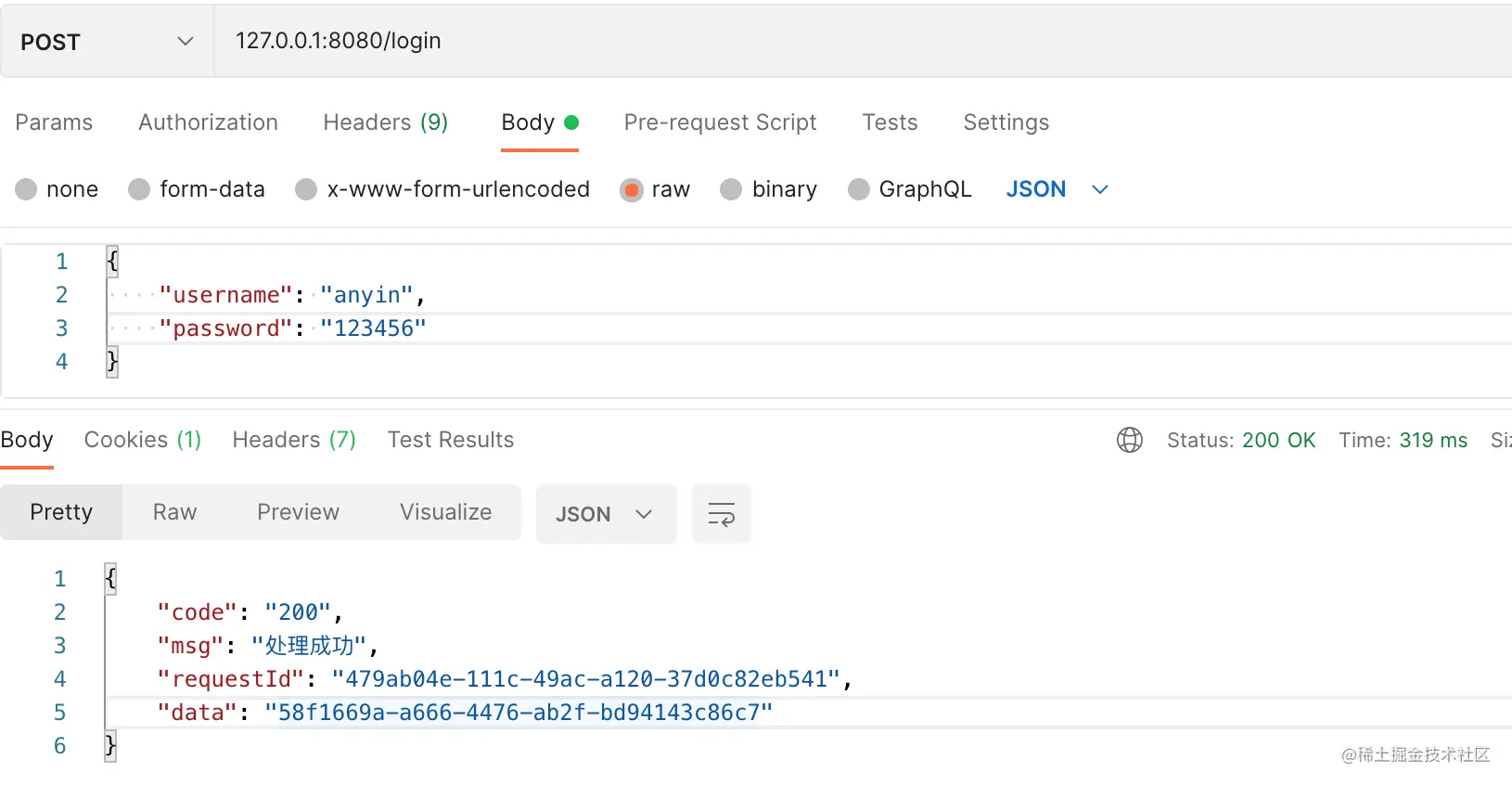

- 正常的業務處理
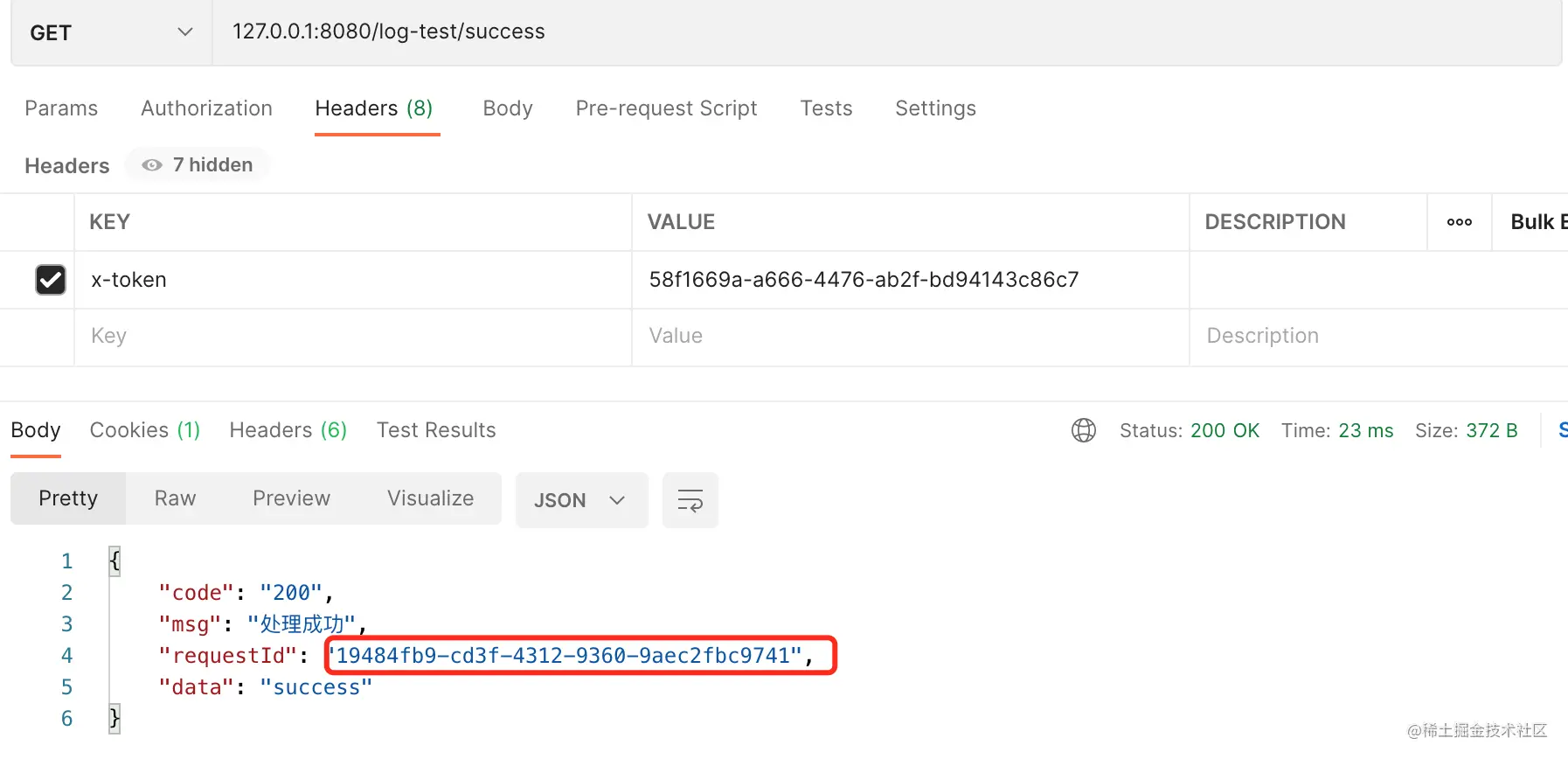

- 發生業務異常
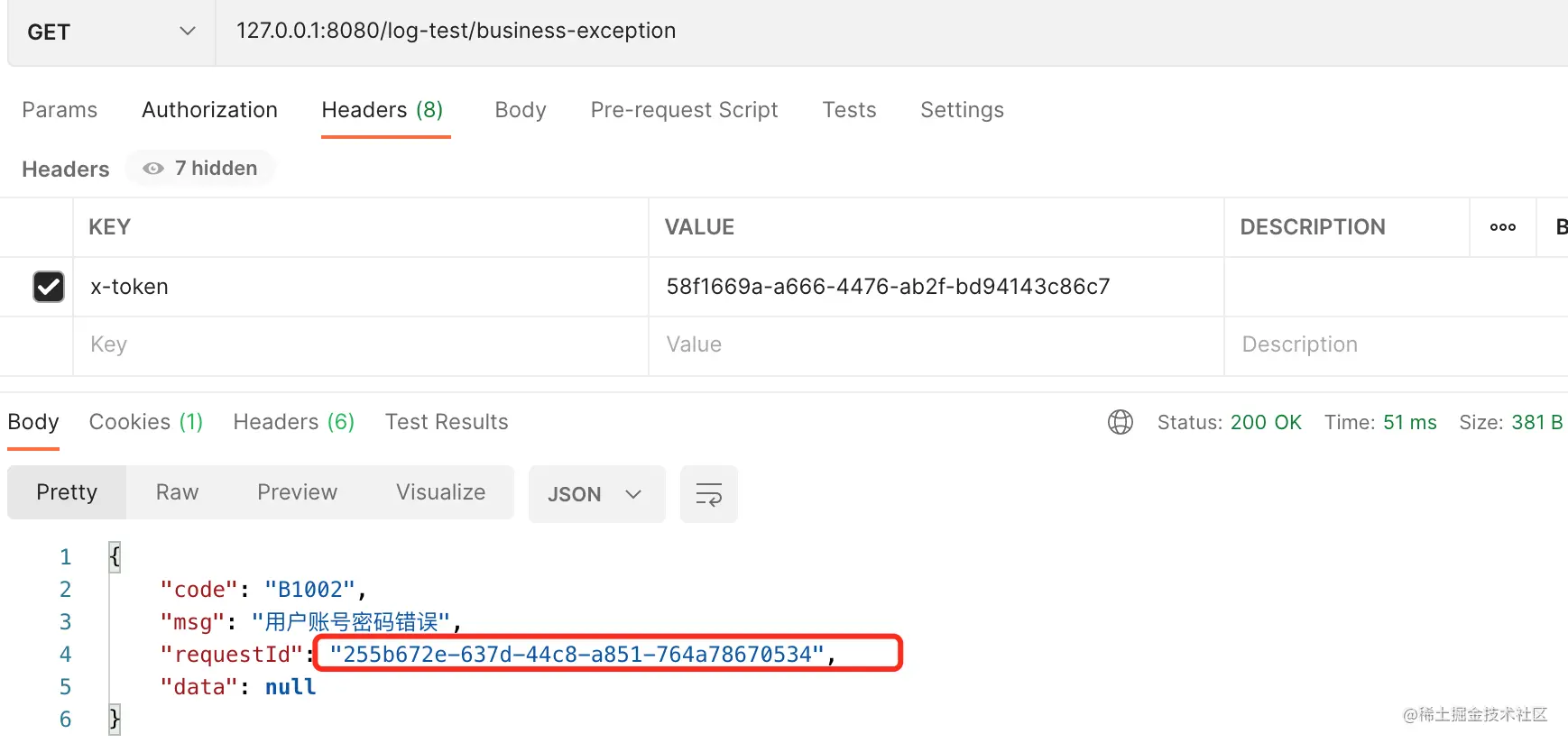

- 發生系統異常
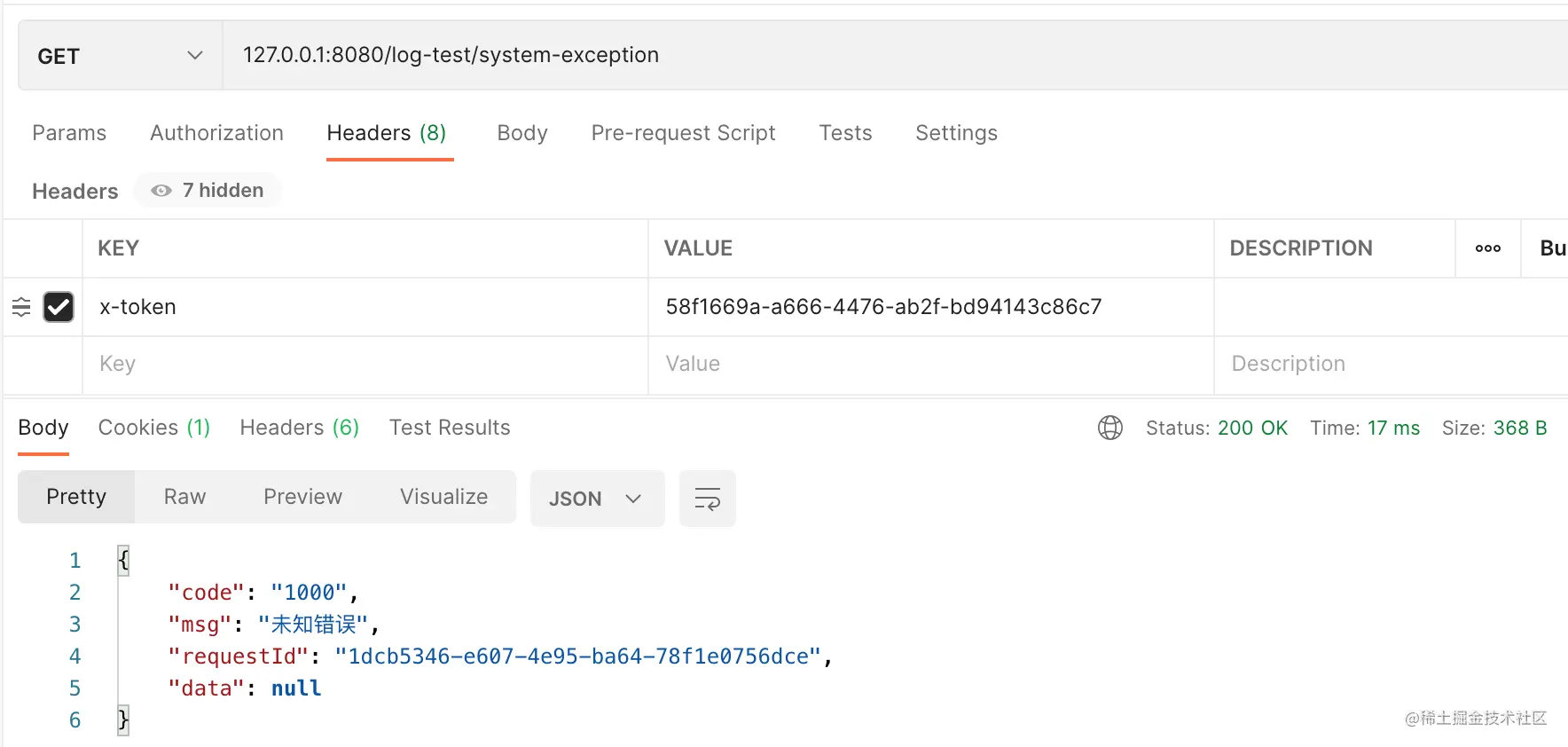

- 異步線程
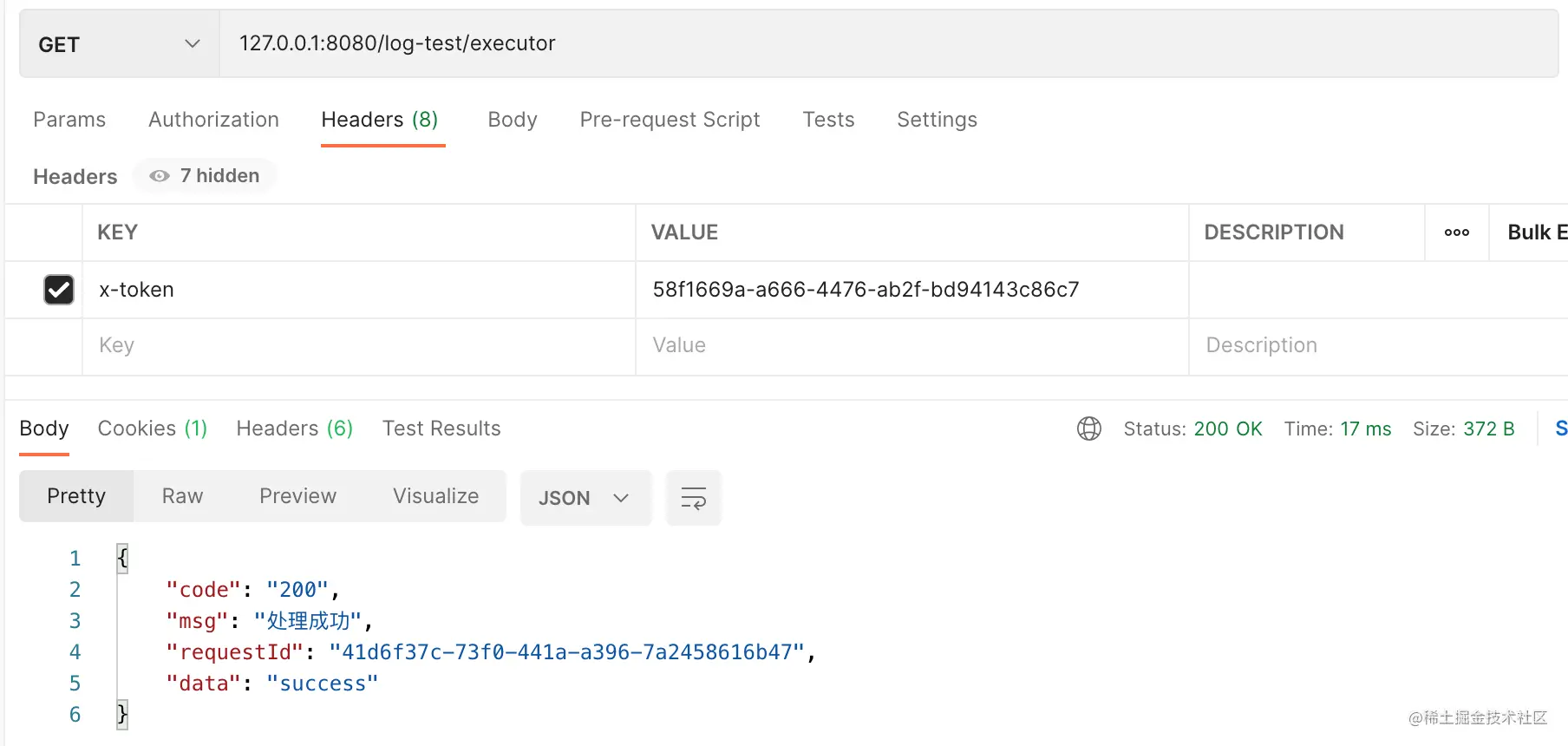

最后
通過以上騷操作,同學,你知道怎么使用RequestId看日志了嗎?






